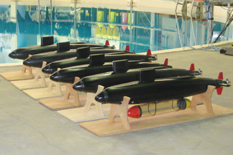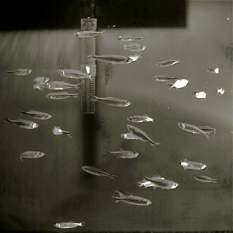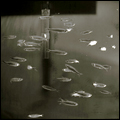Synchronized Swimming for Submarines |
|
FOR IMMEDIATE RELEASE SPECIAL DEMONSTRATION CONTACT: COLLEGE PARK, Md.—Nature shows and Caribbean vacation commercials often depict a school of fish moving as a single entity to avoid obstacles and elude prey. Engineers hope to give unmanned mini-submarines, mini-helicopters and other autonomous vehicles the same coordinated movement.
Derek Paley, assistant professor of aerospace engineering at the University of Maryland's A. James Clark School of Engineering, recently won a National Science Foundation Faculty Early Career Development (CAREER) Award for his proposal to study the coordinated movement of fish and apply it to unmanned submarines. Unmanned vehicles under multi-vehicle control could navigate more accurately and collect data more reliably than individual vehicles. The Navy plans to use a fleet of unmanned submarines to measure oceanic salinity, temperature and density—the factors that affect the speed of sound through water. These measurements, in turn, will help better predict sonar performance.
Fish signal one another via visual cues and hydrodynamics (the movement of water). A line of tiny hair cells down each side of a fish helps them to sense the flow of the water around them. Paley is giving a fleet of mini-subs onboard cameras to mimic the visual sensing of fish. Also aboard each 3-foot-long sub is a tiny computer that can process the information from the cameras to determine the relative position of the subs around it and use this information to steer. Meanwhile, undergraduate student Alexander Leishman is developing sensors for Paley’s subs that will mimic the hair cells of the fish, to help the subs sense changes in the flow of the water. In lab space provided by biology professor Arthur Popper on the College Park campus, Paley has set up a network of cameras to monitor a school of giant danios (hardy freshwater fish about three inches long) and how they react when they are startled. When one or more fish in a school is startled, they trigger what is known as a "wave of agitation"—one fish takes evasive action, its immediate neighbors follow suit, followed by their neighbors, and so on. Paley takes the data captured by the cameras and uses it to create 3-d reconstructions of the fish movement. The models will help his research team better understand the information transmission among the fish and apply the same principles to the unmanned vehicles. "We're developing modern engineering tools to quantitatively study this phenomenon," Paley says. "We're taking methods you learn as an engineering student and applying them to study biology." The technology being built for the subs also can be applied to unmanned aerial vehicles. "We're looking at planetary-scale applications for these vehicles; for instance, monitoring conditions inside hurricanes to improve forecasting models," Paley said. "It's important to fly lower—below 10,000 feet—to collect data where the air meets the water," explains Paley. "Manned aircraft can't fly that low inside a hurricane for safety reasons." Paley directs the Collective Dynamics and Control Lab, where he supervises the research projects of twelve undergraduate engineering students who help him build the autonomous submarines. Paley also has six graduate students working on related research including Sachit Butail, a doctoral candidate who is developing an automatic tracking system to monitor the fish and produce data at an unprecedented rate and volume. This fall, Paley will add a neuroscience grad student to his team who will help design and conduct experiments to glean more from the communication behaviors of the fish. NOTE TO EDITORS: Outside of the media event on May 5, one day's notice is needed to set up our facilities for camera crews – please plan accordingly. More Information: Collective Dynamics and Control Lab About the A. James Clark School of Engineering The Clark School's graduate programs are collectively the fastest rising in the nation. In U.S. News & World Report's annual rating of graduate programs, the school is 22nd among public and private programs nationally, 10th among public programs nationally and first among public programs in the mid-Atlantic region. The School offers 13 graduate programs and 12 undergraduate programs, including degree and certification programs tailored for working professionals. The school is home to one of the most vibrant research programs in the country. With major emphasis in key areas such as communications and networking, nanotechnology, bioengineering, reliability engineering, project management, intelligent transportation systems and space robotics, as well as electronic packaging and smart small systems and materials, the Clark School is leading the way toward the next generations of engineering advances. Visit the Clark School homepage at www.eng.umd.edu.
|
|
||||||||||||||||||||||||








